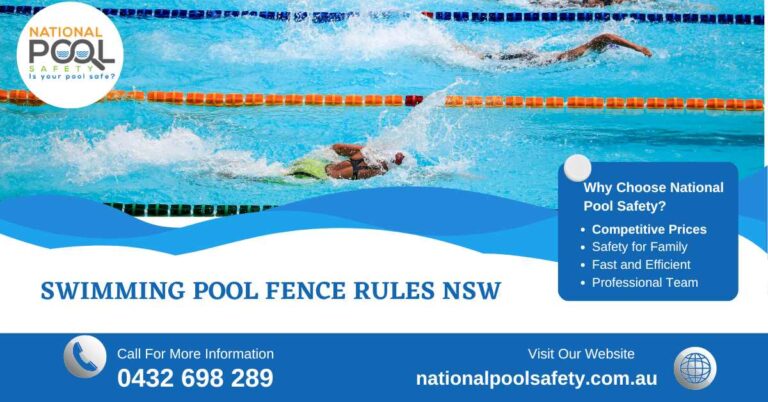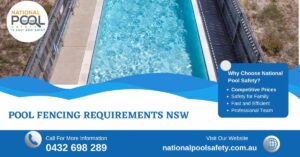Swimming Pool Fence Rules NSW

In New South Wales (NSW), swimming pool safety is a top priority, particularly when it comes to preventing tragic accidents involving young children. Adequate pool fencing is one of the most important safety measures for any pool owner. With the goal of reducing drownings, the NSW government has outlined specific laws and standards regarding pool fencing that pool owners must follow to ensure their swimming pool is safe and compliant with regulations. Here’s everything you need to know about swimming pool fence rules in NSW.
What Are the Pool Fencing Laws for NSW?
NSW has strict laws surrounding pool fencing, and the requirements vary depending on when the pool was built. These laws aim to reduce the risk of drowning by ensuring that pools are properly fenced off and inaccessible to young children. There are three different Australian Standards that apply to pools built at different times:
Pools Built Before 30 August 2008:
- Pools constructed prior to this date must comply with AS 1926-1986, which covers the safety of private swimming pools.
Pools Built Between 1 September 2008 and 30 April 2013:
- These pools must adhere to AS 1926.1-2007, which outlines requirements for safety barriers for swimming pools.
Pools Built After 1 May 2013:
- All new pools must meet the AS 1926.1-2012 standard, which sets out the most current safety barrier requirements.
What is the Code for a Fence Around a Pool?
The code for fencing around a pool in NSW is designed to ensure that the pool is properly enclosed, preventing young children from gaining access without adult supervision. Here are the key requirements for pool fences in NSW:
- Height: The fence must be at least 1.2 meters high from the finished ground level. If a boundary fence is part of the pool fence, it must be 1.8 meters high.
- Gaps: There should be no gaps greater than 10 cm at the bottom of the fence, and any vertical bars in the fence should not have gaps greater than 10 cm between them.
- Climbable Bars: Horizontal bars should be spaced at least 90 cm apart to prevent children from climbing over them.
- Mesh Fences: For mesh or perforated barriers, the holes must not exceed 13 mm for a fence height of 1.2 meters, or 100 mm for a 1.8-meter-high fence.
What Are the Rules for Fences in NSW?
Pool fencing in NSW is governed by several rules to ensure the safety of children. Here are some of the essential rules:
- Non-Climbable Zone: A 90 cm non-climbable zone must be maintained around the pool fence. This means that no trees, shrubs, toys, ladders, or other climbable objects should be within this area. This zone extends 30 cm into the pool area as well.
- Gates: Pool gates must be self-closing and self-latching. They should swing outwards (away from the pool area) and must not have any pet doors. The latching device must be at least 150 cm above ground level to prevent children from opening the gate.
- Windows and Doors: Windows or doors that are part of the pool barrier must not open more than 10 cm. If they do, they need to be fitted with a locking device or security screen.
- Signage: A CPR sign must be displayed near the pool, and it must be legible from a distance of at least 3 meters.
Additional Considerations for Pool Fencing
In addition to the basic safety requirements, the following considerations are important for pool owners:
- Spa Pools: If your spa pool does not have a secure, child-resistant cover or structure, you must install a fence to prevent access to the area when not in use.
- Inflatable Pools: Even inflatable pools require fencing if they are 300 mm or more in height. Smaller inflatable pools should come with warning labels regarding child safety and supervision.
Construction Sites: During the construction of a pool, builders must ensure that the site is securely fenced off. Once the pool is complete, the owner must maintain a “not to be used” sign until a compliance certificate is issued.
Maintaining Pool Fencing Compliance
To remain compliant with the pool fencing laws in NSW, regular maintenance is crucial. This includes ensuring that gates are self-closing and self-latching, checking the condition of the fence, and repairing any damage promptly. It’s also important to ensure that the pool fence remains clear of any climbable objects or obstacles.
Conclusion
Ensuring that your pool is properly fenced is not just a legal obligation in NSW—it’s a vital step in safeguarding young children from potential drowning accidents. By adhering to the pool fencing laws and regularly checking the condition of your pool barriers, you can enjoy your pool while providing a secure environment for your family and guests.
For more detailed information about pool fencing compliance and regulations, you can visit the Nationalpoolsafety




